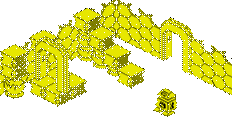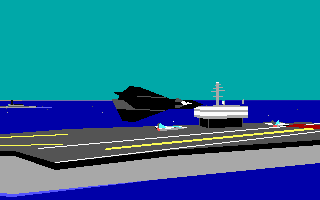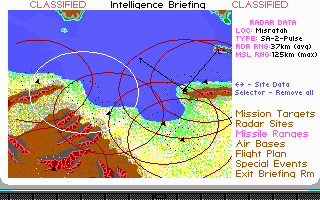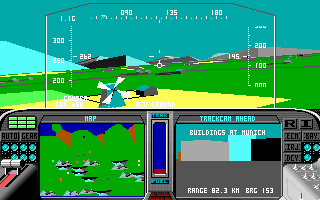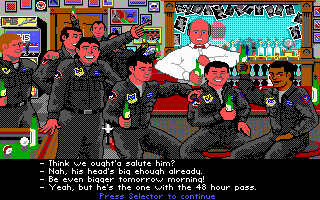| Details (IBM PC) |
|
Supported platforms |
Artwork and Media |
Publisher:
Genre:
Author(s):
Musician(s):
Minimum Spec:
Recommended Spec:
Minimum Memory Required:
Maximum Players:
Joysticks:
Language:
Media Code:
Media Type:
Country of Release:
Related Titles:
Comments:
|  Microprose Software Ltd Microprose Software Ltd
Flight Simulator
Andy Hollis, Sid Meier, Jim Synoski, Max D. Remington III, Murray Taylor, Bruce Shelley, David McKibbin
Ken Lagace
8088/8086 CPU, DOS 3.0, CGA/Hercules, PC Speaker
80286 CPU, DOS 3.3, VGA/MCGA, Adlib/SoundBlaster, Analog joystick
384K
1
Yes
Eng
5.25" floppy disk
UK
Night Hawk: F-117A Stealth Fighter 2.0
At the time of the game's release there was heavy speculation surrounding a missing aircraft in the United States Air Force's numbering system, the F-19. This game was based on an educated guess about what the new
| Click to choose platform:
Atari ST
Sinclair ZX Spectrum
Commodore Amiga
IBM PC
|
Please login to submit artwork |
| Videos | Screenshots (IBM PC) | |
| |
Please
login to submit a screenshot
 Version info
Version info (Unknown) 30th Nov 2015 03:28
The game DID support Adlib emulation, but only in later versions. If you didn't keep it from back then (a mistake I made and I still regret), bear in mind that the version around the abandonware sites is the first one (403.0), with some bugs and lack of Adlib support.
The final version (403.04) supports Adlib and has some other changes/additions. If you really want Adlib sound in your 403.00 game, you can copy the ASOUND.EXE from F-15 Strike Eagle II into the F19 directory, and then run it by typing "f19 /aa". The title song will sound weird, but the rest of the sounds are like it would be with the final version.
 (From the game manual)
(From the game manual) (Unknown) 26th May 2011 09:58
A fascinating section of the F-19 manual explains the process behind its design (and the design of computer games in general:
The Design Team
Simulations such as F-I9 Stealth Fighter require a large, talented creative team to produce. The 16-bit version was engineered by that now-famous team of Sid Meier (master of algorithms and data structures that recreate reality) and Andy Hollis (one of the hottest 3-D and assembly programmers in the nation).
Sid’s the founding father of MicroProse (along with President “Wild Bill” Stealey), and brings a veteran viewpoint of game programming and game design. A large number of features in this product started with Sid saying, “Wouldn’t it be neat if The neat part is that Sid then goes and implements the code that very day!
Andy is one of MicroProse’s veterans, and has done fast, tight 3-D code before —in C64 Gunship, and then again in IBM Gunship. Each time Andy finds new ways to get more, faster, in less space. Andy isn’t our only 3-D expert. For example, he used some Scott Spanburg’s secret and magical object logic, which Scott had just finished conjuring for another (future) MicroProse product. Andy’s a great fan of high speed anywhere: in computers and in cars (he races autocross in his spare time).
Jim Synoski, creator of the original C64 Stealth Fighter, was dragged into this version to help out. He was nice about it, especially about all the things Sid changed! He worked with ace computer artist Max (“Maximum”) Remington to create the entire preflight and postf light system. Even an “old guard” expert like Jim, veteran of many other MicroProse games, can be impressed (distressed?) by the complexity and detail involved in Briefings and Debriefings. The apparently limitless variety of IBM graphics modes (VGA, MCGA, EGA, CGA, Tandy and Hercules) doesn’t help!
The 3D databases for the four “worlds” were created by game designer Bruce Shelley and artist Max Remington. It was here that “Maximum” got his nickname. For a while every object he created went right to the data space maximum, causing something new to “blow” in Andy’s code, like an engine overrevving too far. Fortunately 3D graphic glitches are fairly obvious to a trained eye — all were spotted and eventually fixed. Bruce’s job was more difficult. A veteran of many board wargame designs, he worked within the very complicated and often frustrating limitations of a microcomputer’s data space layout. The remarkable fidelity of the data space world to the “real” world is a testament to his perseverence. Fortunately he was a good sport through it all, perhaps inspired by the 7:00 AM basketball games in the warehouse with ‘Major Bill’ and other B-ball fanatics within MicroProse.
All this data and graphics takes up a lot of room. In fact, F-IS Stealth Fighter on our development systems occupies about five megabytes (fifteen 360K floppy disks!). It’s problems like these that David McKibbin was born to solve. His compression schemes “shrank” the code and data to its current size! Every time the disk drive loads something, it runs through a special “decompressor” that expands the code andior data to “full size” in memory. This means you’re getting a product that would otherwise require a hard disk and command a retail price well over $100. So David’s saving you a lot of cash as well as making F-19 commercially viable.
The paper materials were conceived by designer Arnold Hendrick, author of this manual. Usually MicroProse’s marketing department is concerned about the size, weight and cost of our manuals (not that it does any good, the manuals always go over budget). But for this product the word was, “go all out”. Arnold took them at that, although they gulped hard when the page estimate jumped from 128 to 192! The rumor that marketing’s office furniture was pawned to pay for the extra paper is entirely unfounded. Incidentally, the design, layout and artwork of the manual, maps and overlays were all done on computer with final output on Linotronic typesetters. In his alter ego as manager of the game design group, Arnold kibbitzed unmercifully about various aspects of the design. Surprisingly, Sid, Andy, Jim and Bruce even took him seriously (at times).
Murray Taylor, 3-D artist extraordinaire, designed the basic “look” of this manual, executed the weapons illustrations, and did the six full-page computer pictures that grace these pages. How he finds time for the triathlon remains a mystery even within MicroProse.
Barbara Bents did yeoman (yeowoman?) work with the technical drawings, maps and keyboard overlays. MicroProse uses state-of-the-art drafting and layout software on MacII’s for many internal graphics. Barbara’s designs, however, consistently went beyond the abilities of current postscript interpreters. Unfortunately, we didn’t write the software.., so when we phoned the creators they just said, “Oh, gee, sorry. You’ll just have to do less complicated things!” The keyboard overlays were difficult for a different reason: we redesigned about as fast as she could redraw them on the Mac! For surviving these trials and tribulations, she wins MicroProse’s competitive and coveted “most tolerant artist of the year” award.
Everybody at MicroProse takes Ken Lagace for granted. He’s the quiet. silver-haired gent who gave up teaching and performing professional classical music for a career as a computer sounds composer, with scores of brilliant scores to his credit. You’ll probably take him for granted too, since the sounds for F-l9 Stealth Fighter fit right in!
Finally, the QA (quality assurance) staff at MicroProse approached this product like all others: with the maniacal glee of a mad scientist! Al Roireau, Chris Taormino and Russ Cooney just love to find bugs, then torment the poor, exhausted programmers with multi-page bug reports. In fact, they enjoyed itso much they stayed late nights, then came in on Saturdays and Sundays, for weeks on end, for just that purpose. In fact they’re still cackling over the airfield-in-the-ocean bug, or the 1500 kts level flight bug, or... well, you get the idea. Unlike many software companies, at MicroProse QA really does have the final say for shipment. Until “Big Al” gives thumbs up, the product stays in testing and the programmers continue slaving over the bugs.
 TextFiles.com
TextFiles.com (Unknown) 10th Jun 2012 05:48
F-19 STEALTH FIGHTER
Microprose beat the United States Air Force by a couple of months in releasing
the Stealth Fighter. Never mind that the USAF calls it the EF117-A; the mission
is radar evasion. F-19 STEALTH FIGHTER is an unusual air combat simulator. It is
also one of the best.
This review is based on the IBM-PC/compatibles version. I tested F-19 STEALTH
FIGHTER on a GenTech 386/20 with Everex VGA card and Mitsubishi Diamond Scan
monitor. I used a CH Products Mach IV joystick as the aircraft maneuvering
interface.
F-19 STEALTH FIGHTER is a departure from the usual air combat simulator. An
aircraft that presents a small radar image must compromise on flight
performance. The F-19 is not a hot combat jet like the Tomcat, Eagle, or
Fighting Falcon. It is a subsonic jet designed to get in and out of combat with
little chance of being detected.
Standard U.S. Air Force and Navy tactical doctrine requires combat pilots to
fight as teams. However, a Stealth Fighter would logically fight alone.
Microprose designed true, one-man missions for the F-19. Pilots who can avoi
combat and detection until absolutely necessary are the most successful.
The airplane itself is a low performance strike-fighter, almost an attack
plane. Its military role is clandestine operations. No sane Stealth pilot would
provoke open combat with the more highly maneuverable Warsaw Pact fighters. The
intelligent approach is to sneak up and surprise attack.
The opening screens of F-19 eventually display a roster of pilots. After
selecting an existing pilot or creating a new one, there are five choices to
customize the mission. Theatres of war include Libya, Persian Gulf, North Cape
(USSR near Scandinavia), and Central Europe. Conventional war, limited war, or
cold war are the possible rules of engagement. Mission types combine strike
(ground targets) or air-to-air , training or real. Your opponents can be green,
regulars, veterans, or elites. Landings can be realistic, easy, or "no crashes."
Each option affects the mission's risk factor, displayed at the bottom of the
screen. From green Libyan pilots to elite Warsaw Pact aces, the challenge can be
made easy or very difficult.
The action shifts to a briefing room, where the details of the mission are
explained. A map of the theatre shows primary and secondary targets. A menu
selects additional information to be displayed: radars, air bases, missile
sites, and ground troop concentrations. Surveying the situation improves the
odds for survival.
The armament menu presents choices of fourteen air-to-ground weapons, two
air-to-air missiles, extra fuel, and a camera for reconnaissance missions. The
F-19 has only four weapons bays, so the mission objectives narrow the payload
choices. Some weapons fit two, three, or four to a bay. The documentation has a
detailed chart of ordnance effectiveness against various targets.
There is a menu that allows you to review the briefing, change weapons, or
choose a new mission before taking off. But now it's time to climb into the
cockpit!
As in most jet fighter simulators, there is a head-up display (HUD) in front of
the canopy. Airspeed, heading, and altitude are graphically and digitally
displayed along the left, top, and right edges of the HUD. There are status
indicators for armament selected, gun rounds, G-forces, brakes, and flaps.
Targets appear as boxes, and the size and color of the box show weapon
effectiveness.
The rest of the F-19 cockpit represents state-of-the-art electronic warfare.
Two mini CRTs control the navigation and target acquisition systems. The
navigation system guides the pilot to the mission objectives and back to base. A
unique target finder, called the tracking camera, locks on to air or ground
targets. Once locked, the tracam screen displays distance and bearing, as well
as speed for airborne targets. The tracam and the HUD blink rapidly when the
target is in range of the selected weapon.
Radar evasion is an integral part of this game called Stealth. Between the two
mini CRTs is a device called the Electro-Magnetic Visibility Scale, or EMV. This
bar-graph gauge shows the intensity of your radar signature to the enemy. The
strengths of enemy radar search signals also appear as bars on the EMV. Overlap
of the search radar bar on the radar signature bar means you have been detected.
Radar evasion requires strategic flying. There are two types of radar, called
pulse and Doppler. Pulse radar finds planes by the strength of their
reflections. Doppler radar finds planes by detecting motion either toward or
away from the radar source. By flying straight at pulse radar (to minimize
reflection size), and at a constant distance from Doppler radar (to minimize the
"Doppler shift"), it is possible to lower the chances of being identified.
The missions are classified as either strike or air-to-air. The objectives of a
typical strike mission might be to destroy a terrorist camp, deliver Stinger
missiles to a guerilla group, or photograph a bridge for an air strike.
Air-to-air mission objectives could be to destroy a commando transport plane or
an IL-76 airborne command post. There are approximately fifty different mission
targets.
Medals and promotions are awarded for completing missions successfully.
Missions are rated on a point scale. The greater the risk factor (as determined
by theatre and enemy skill level) the greater the point rating. Microprose
doesn't document the points award algorithm.
I found F-19 STEALTH FIGHTER to be an easy game to learn. The documentation is
excellent. A keyboard overlay makes it a snap to find the numerous function keys
(novice computer fighter pilots will appreciate this feature). The training
missions stress basic flying and weapons usage. Autopilot can fly the plane to
each of its objectives as new pilots concentrate on learning all the aircraft's
systems.
Now, after flying over 100 missions, I am still intrigued by the program. There
are enough combinations of enemy skill, mission type, theatre, and levels of
conflict to prevent boredom. Even though the graphics are low (320 x 200)
resolution, the drawing routines are fast and detailed. I was unable to run VGA
mode on the Everex board, but EGA worked fine.
The sounds Microprose created for F-19 are impressive, especially considering
the limited capabilities of the PC. The jet engines, missile launches, warning
klaxons, and squeal of the tires on touchdown are the best I've heard on a
PC-based flight simulator. I also should mention that the game is copy-protected
in two flavors: key disk and documentation lookup. (I won't add my personal
feelings about copy protection to this review.)
There are a few bugs in F-19 STEALTH FIGHTER, but overall, the quality of the
game is good. My biggest complaint is the lack of an artificial horizon ball in
this marvelous cockpit. I sometimes become disoriented during twisting, turning
dogfights, and can't "get the blue side up" (straight and level flight) in time
to avoid a crash. The ILS is somewhat inaccurate, but the tracam can line up the
runway instead. I feel there is too big a skill difference between regular and
veteran enemies. I have not fought elites as of this writing.
For the computer jet jock who wants to try something really different and
challenging, try F-19 STEALTH FIGHTER. It will entertain you for a long time.
F-19 STEALTH FIGHTER is published and distributed by Microprose Software.
*****DOWNLOADED FROM P-80 SYSTEMS (304) 744-2253
�
|
Add your own review for F-19 Stealth Fighter! Fill in this section now!
|
|
| Cheats | Trivia | | There are no cheats on file for this title. | No trivia on file for this title. |
History
This title was first added on 9th April 2009
This title was most recently updated on 30th November 2015

 Microprose Software Ltd
Microprose Software Ltd Version info (Unknown) 30th Nov 2015 03:28
Version info (Unknown) 30th Nov 2015 03:28 (From the game manual) (Unknown) 26th May 2011 09:58
(From the game manual) (Unknown) 26th May 2011 09:58 TextFiles.com (Unknown) 10th Jun 2012 05:48
TextFiles.com (Unknown) 10th Jun 2012 05:48
